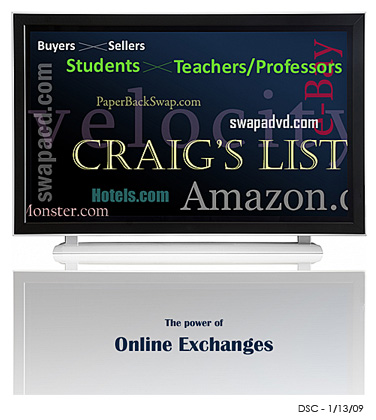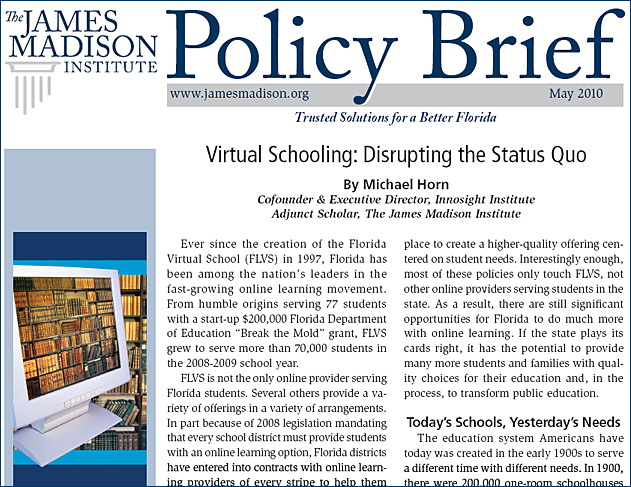Parents get help in choosing an online-learning program — eSchoolNews.com
Also see:




Online high school courses grow in popularity — from Boston.com by Michele Morgan Bolton [item via Ray Schroeder]
Pape and others said the Virtual High School concept is a perfect blend of screen and face-to-face class time that prepares students for college. Similar online efforts are gaining ground elsewhere as well; New Hampshire’s Virtual Learning Academy, for example, has more than 7,000 students.
The Virtual High School proves that the Internet is not just about downloading, Pape said: “It’s about creating.’’
The International Association of K-12 Online Learning, meanwhile, says 10 percent of all courses will be computer-based by 2014, and in 2019 about 50 percent will be online.
Additionally, educational technology consultant Ambient Learning says 2 million American high school students are already learning online, a number expected to jump to 10 million by 2014.
From DSC:
Consider the following timeline of the Florida Virtual School according to this article:
1997: Florida Virtual School is founded.
2002: Hillsborough County establishes a virtual school program for high school classes.
2007: Hillsborough County starts offering middle school classes.
2008: Hillsborough County starts the elementary program.
2009: New state law requires school districts to offer full-time virtual classes for K-12 students.
Now consider that they started with 77 students.
Now consider that the “…program served more than 71,000 students during the 2008-2009 school year, according to its Web site.” (emphasis DSC)

Do not underestimate the disruptive impact of technology.
And I realize it’s not just about the technology…it’s about people.
But technology can connect people to each other at ever-increasing speeds.
Quotes from Traditional schools aren’t working. Let’s move learning online. — from the Washington Post by Katherine Mangu-Ward
From DSC:
The title of this posting makes this transition sound so easy and it is probably too simplistically stated. However, she has some great points (emphasis DSC):
Smart kids are bored, and slower kids are left behind. Anxiety about standardized tests is high, and scores are consistently low. National surveys find that parents despair over the quality of education in the United States — and they’re right to, as test results confirm again and again.
But just as most Americans disapprove of congressional shenanigans while harboring some affection for their own representative, parents tend to say that their child’s teacher is pretty good. Most people have mixed feelings about their own school days, but our national romance with teachers is deep and long-standing. Which is why the idea of kids staring at computers instead of teachers makes parents and politicians extremely nervous. (From DSC: Removing the human element is not the goal here. In fact, technology connects human beings all the time — student to student, student to teacher/faculty member. The difference is that the teacher now has diagnostic tools to work with and students can pursue their passions. A teacher doesn’t need to be able to teach everything — an impossible task anyway these days.)
However, it’s time to take online education seriously — because we’ve tried everything else.
Since the Internet hit the big time in the mid-1990s, Amazon and eBay have changed the way we shop, Google has revolutionized the way we find information, Facebook has superseded other ways to keep track of friends and iTunes has altered how we consume music. But kids remain stuck in analog schools. Part of the reason online education hasn’t taken off is that powerful forces such as teachers unions — which prefer to keep students in traditional classrooms under the supervision of their members — are aligned against it.
In the 2010 annual letter from his foundation — the biggest in the United States, with a $33 billion endowment — Bill Gates listed online education as one of his top priorities and rattled his pocket change in the direction of reform. He wrote: “Online learning can be more than lectures. Another element involves presenting information in an interactive form, which can be used to find out what a student knows and doesn’t know.”
How do we know online education will work? Well, for one thing, it already does. Full-time virtual charter schools are operating in dozens of states.
Few people have a clear picture of what online education really looks like, which is one reason so many people are reluctant to consider what it has to offer.
Wimba Connect 2010 — check out the applications of these tools
OPENING KEYNOTE
Carol Vallone, CEO, Wimba
Teaching Math & Sciences with Wimba (Panel)Andrew Byrne & Kurt Mederer, Convent of the Sacred Heart; David Tao, Santosh Madhavan & Dan Lim, Florida Hospital College of Health Sciences; Michele Barbeau & Kem Rogers, The University of Western Ontario
Using Wimba to Engage and Empower an Academic Community of Learners: The Case of the Global Citizen
Linda Ralston & Rebekah Grow, University of Utah
Faculty Development Wimba Style
Janet Welch & Stacey Mateika, Red Deer College
Using Wimba Voice, Pronto, and Create in Synchronously in Wimba Classroom and Asynchronously in an Online Environment
Brooke Eberwine, Steven Frecka & Jamie Westyn, OHDELA
Small Scale Implementation of Wimba Classroom – The Possibilities Are Endless
Regina Bobak & Julie Wolfe, Bloomsburg University of PA
Language Learning with Wimba (Panel)
Teresa MacKinnon, University of Warwick Language Centre; Ana Garcia Allen, The University of Western Ontario; Barbara Cohen, Berkeley College
Wikis, Wimbas, Whatevers! What Teachers Weave!
Jane Overmoe, Dakota Prairie HS
Taking the Troy Colloquium Online + Wimba: The Solution to Quality Online Learning
Gayle Nelson & Peter Paige, Troy University
Wimba Product Presentation
Annie Chechitelli, Wimba
Presentations Live or On-the-Go with Wimba Classroom MP4 Archives
Jason Rhode, Northern Illinois University & Larry Holland, University of Arkansas at Little Rock
NCVPS Cultural Cafe
Thomas Moncrief, North Carolina Virtual Public School
Our Journey: From Face 2 Face 2 Online Masters Degree
Gary Shouppe & Tom McCormack, Columbus State University
So Many Choices, So Little Time: Effective Voice Tools Training
Stacey Powell & Kathy McClelland, Auburn University
Features, Technical Problems and Technical Support in Higher Education Wimba Classrooms
Mary Nell McNeese, Amy Thornton & Jalynn Roberts, University of Southern Mississippi
ALAKAZAM!!! Instantly Transform your Physical Classrooms into Lecture Capture Spaces Using Wimba!
Scott Smith & Brian Reed, Wimba; Mark Burris, Michael Merritt & Linda Stauffer, University of Arkansas at Little Rock
Using Wimba to Prepare for H1N1 and other Potential Disasters (Panel)
Phil O’Hara & Tim Fedak, Dalhousie University; David Tao & Dan Lim, Florida Hospital College of Health Sciences
Diminishing the Distance in Distance Ed – Wimba’s Live Tools: People Reaching People
Crystal Havely Stratton & Patricia Landy, Laramie County Community College
“Keep It Live” – What the Students Say!
Mike Scheuermann, Drexel University
Wimba Pronto 4 All: Pronto Invitations and Universal Integration
Marlen Rattiner & Chris Dixon, Wimba
Online Learning is all about Collaboration!
Mark Gensimore, Jed Friedrichsen & blendedschools.net
Bringing In Local and Global Guest Speakers through Wimba Classroom
Chunyan Song , Ann Steckel & Laura Sederberg, California State University, Chico
Envelop, Develop: Building a Statewide and College-Level Professional Development System with Wimba and your LMS
Terry Pollard & Christian Pruett, Mississippi SBCJC; Rebecca Butler, Northwest Mississippi Community College; Jennifer Nowotny, Wimba
Where Did My Wimba Go and Do Users Know It’s Missing?
Michael Rogers & Jim Wolfgang, University System of Georgia; Sean Hessenthaler, Wimba
The Professor is In: Lessons Learned in Delivery of Online Student Support
Michelle Escudier & Sharon Davis, Central Texas College
Pet Kangaroos and Other Tall Tails – Live and MP4 Examples, Best Practices and Case Studies on Using Wimba Down Under
Steve Watt & Thalia Cosmidis, NetSpot Pty Ltd
Reaching Over Wall: Linking Kindred Spirits via Live Web Conferencing
Phil O’Hara & Corinne Tobin, Dalhousie Unversity; Paul Lowe, University of the Arts London
Collaborating With Students – A Glimpse of the Future With Blackboard
Brian DeKemper, Solutions Engineer, Blackboard
The Blended Language Learning Consortium (presented remotely)
Paul Snookes & Judy Barker, University of Worcester
Bringing Wimba out of the Web and into the Classroom
Bryan Vandiviere, Kansas State University
Wimba Classroom Beyond Classes
Cory Stokes, Univeristy of Utah & Edwin Perez, Wimba
The Power of Wimba 6.0 Archives: Developing and Editing the Archive Library
Jun Yang, University of Maryland
From the Lands Down Under – Wimba Firing Up Staff and Students in Australia and New Zealand
Lisa Ransom & Oriel Kelly, Manukau Institute of Technology; Kerry Trabinger, Canberra Institute of Technology
A Triple Threat to Student Attrition: Three Disciplines, Three Perspectives, and Three Uses of Wimba Classroom to Improve Student Retention
Monica Brooks, Tracy Christofero, Karen Mitchell, & Marty Laubach, Marshall University
High Impact Pedagogy: Bringing Online and Blended Courses to ‘Life’ through Learning Simulation and Wimba
Kristen Betts, Drexel University
Video, Vodcasts, and YouTube – Oh My!
Sarah Bryans Bongey & Chery Takkunen, The College of St. Scholastica
Online Education and the Power of Web 2.0 for Student Retention
Felice Nudelman, The New York Times / Epsilen
The Ways Wimba Classroom Can Revolutionize the Offering of Online Degree Programs
Daniel Powell, University of Alabama School of Law
Using Breakout Rooms to Foster Faculty Development
Ann Morgan, Kelly Kist & Heather Zink, Rasmussen College
Computer Science “eXperience:” Using Wimba Tools to Enhance Computer Science Education
Adel Abunawass, Alexandra Young & Edwin Rudolph, University of West Georgia
The Virtual Student Experience: Addressing Emotional & Multiple Intelligences & Soliciting Student Feedback
Dawn Muhammad, Calumet College of St. Joseph & H. Jean Bryan, Ed.D., DePaul University
CLOSING KEYNOTE BY JEFF NOEL, THE DISNEY INSTITUTE
Jeff Noel, The Disney Institute
Poster Presentations
K12Online Presentation: Around the World with Skype — Silvia Tolisano — via Dr. Z. and Wes Fryer
Support grows for K-12 online learning — from education-portal.com
Virtual schools and online learning initiatives have exploded across the country, offering students expanded courses and alternatives to traditional education. The Alliance for Excellent Education recently released a brief endorsing e-learning and digital classroom technology as a possible solution to several major crises in elementary and secondary education.
NC Virtual School Offers Statewide Access to Streaming Digital Content — from The Journal by Scott Aronowitz
North Carolina Virtual Public School (NCVPS) has announced it has signed an agreement to offer free access to Discovery Education streaming, the company’s digital video-based learning system, to educators and students throughout the state. The school has also chosen the company to provide professional development services for its educators.

From DSC: Here are a couple of items to highlight the continued power of the Internet to create exchanges & new business models within the worlds of education — both for K12 as well as for higher ed:
From DSC:
The above reminds me of a graphic I did last July:
Provost Academy Launches Colorado’s Online High School — from VirtualSchoolNews.com
Provost Academy, a tuition-free public online high school, announced today it is opening its virtual doors to Colorado students. Backed by EdisonLearning’s experience in preparing more than 1 million students for college and the workforce, Provost Academy provides students personalized learning plans adapted to meet their schedule and specific academic needs.
As a new state-authorized public online school, Provost Academy Colorado is free of charge to residents of Colorado. Students work toward their regular public high school diploma – recognized by colleges and employers – as they would in a traditional school, but in the convenient, safe environment of their own home through computer-based educational programs.
Provost Academy Colorado offers more than 100 highly engaging online classes, including A.P. and honors courses with a particular emphasis on high demand subjects, such as science, technology, engineering and math (STEM). The school also provides students free computers and internet access while they are enrolled in the school.
